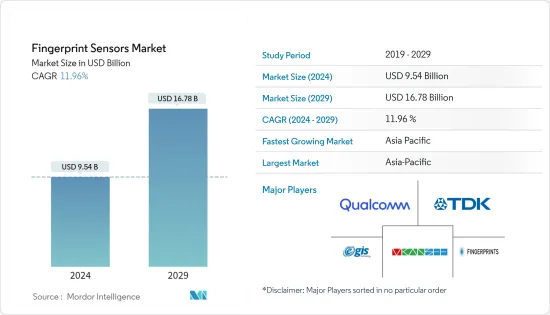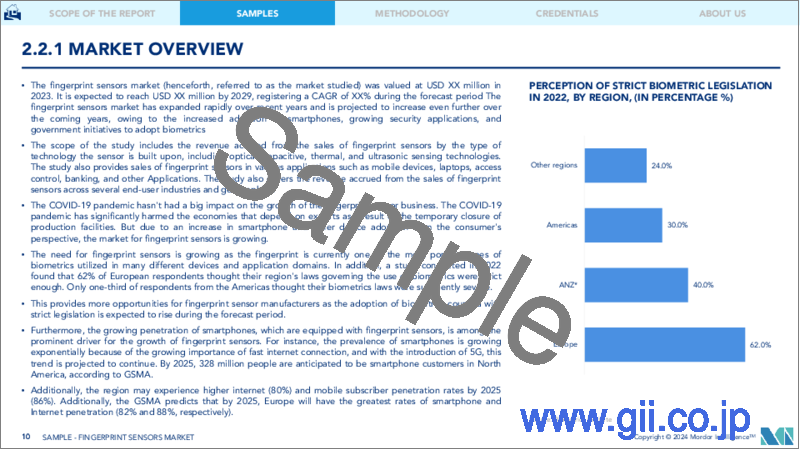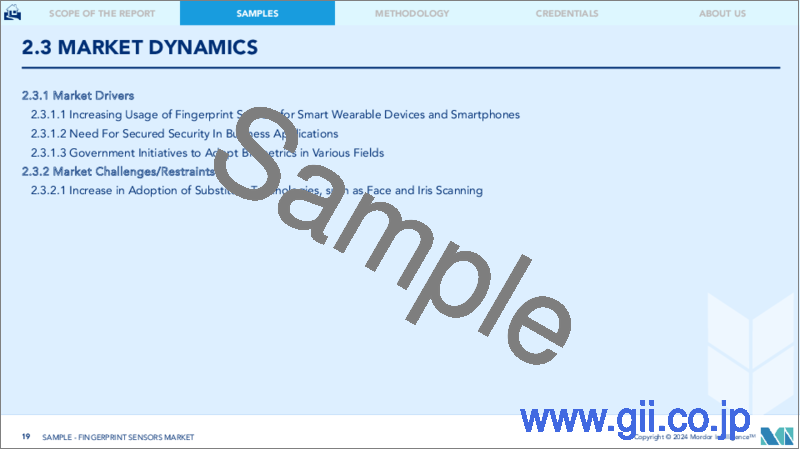|
|
市場調査レポート
商品コード
1444142
指紋センサー:市場シェア分析、業界動向と統計、成長予測(2024~2029年)Fingerprint Sensors - Market Share Analysis, Industry Trends & Statistics, Growth Forecasts (2024 - 2029) |
||||||
|
● お客様のご希望に応じて、既存データの加工や未掲載情報(例:国別セグメント)の追加などの対応が可能です。 詳細はお問い合わせください。 |
|||||||
| 指紋センサー:市場シェア分析、業界動向と統計、成長予測(2024~2029年) |
|
出版日: 2024年02月15日
発行: Mordor Intelligence
ページ情報: 英文 157 Pages
納期: 2~3営業日
|
- 全表示
- 概要
- 目次
指紋センサー市場規模は、2024年に95億4,000万米ドルと推定され、2029年までに167億8,000万米ドルに達すると予測されており、予測期間(2024年から2029年)中に11.96%のCAGRで成長します。

指紋センサー市場はここ数年で急速に拡大しており、予測期間中にさらに拡大すると予測されています。スマートフォンの普及の増加、セキュリティアプリケーションの増加、および生体認証を採用する政府の取り組みが、世界的に指紋センサーの需要を促進する主な要因となる傾向があります。
主なハイライト
- 指紋は、さまざまなデバイスやアプリケーション分野で使用される代表的な生体認証の1つであり、そのため指紋センサーの需要が増加しています。さらに、バイオメトリクス研究所が2021年 6月に世界中の360人の回答者を対象に実施した調査によると、欧州の回答者の56%がバイオメトリクスに関する厳格な法律に同意しています。
- 指紋センサーを搭載したスマートフォンの普及の拡大は、指紋センサーの成長の顕著な促進要因の1つです。たとえば、counterpointの報道によると、2021年第1四半期のSamsungなどのスマートフォンの出荷台数は世界で約7,700万台、iPhoneの出荷台数は世界で5,700万台でした。
- それに伴い、タブレット、ラップトップ、スマートフォン、スマートウェアラブルなどのインテリジェントデバイスの1人当たりの数は、今後数年間で増加すると予想されます。これらのデバイスには指紋センサーが組み込まれることが増えています。 Ciscoによると、2018年には1人あたりのネットワークデバイスの数は8台でしたが、2022年までに1人あたり13.6台に達すると予想されています。
- 高速インターネットアクセスの影響拡大によりスマートフォンの普及率は飛躍的に増加しており、5Gの登場によりスマートフォンの普及率はさらに高まることが予想されます。 GSMAによると、北米のスマートフォン加入者数は2025年までに3億2,800万人に達すると予想されています。さらに、2025年までに、この地域では携帯加入者の普及率(86%)とインターネット(80%)が増加する可能性があります。さらに、GSMAによると、2025年までに欧州はインターネット普及率(82%)とスマートフォン(88%)が最も高くなると推定されています。
- 顔認識システムはさまざまなデバイスでますます一般的になりつつあります。たとえば、Apple、Samsung、OnePlusなどの主要なスマートフォンベンダーは、すでにこのユーザー認証を組み込んでいます。この代替技術の採用の増加は、指紋センサー市場の成長を妨げる可能性があります。
- COVID-19のパンデミックにより、スマートフォン、ラップトップ、PC、タブレットなどの家庭用電化製品の需要が増加しました。たとえば、RBC.ruによると、2020年 3月のパンデミックの最中にロシアでノートブックの売上が増加し、50%の伸びを占めました。
指紋センサー市場動向
スマートフォン向けアプリケーションが大きなシェアを握ると予想される
- スマートフォンは、調査で検討された他のすべてのデバイスの中で、ユーザー認証に指紋センサーを利用する最大のセグメントです。スマートフォンへの指紋センサーの最初の適用は2011年に東芝によって行われましたが、Apple Touch IDはモバイルデバイスの指紋センサーに革命をもたらしました。
- AppleのTouch IDは静電容量技術に基づいており、正確で使いやすいため、ユーザーの認証は高速かつスムーズになりました。 Appleの成功の後、Samsungや他の大手企業も認証にさまざまな指紋技術を使用し始めました。
- テクノロジーに関しては、静電容量式タッチスクリーンセンサーは、高級携帯電話では超音波指紋センサーに、残りのデバイスでは光学センサーに置き換えられています。静電容量センサーからの移行は、ディスプレイにセンサーを統合する需要の高まりによるものです。
- 一方、タブレットでは静電容量センサーが使用されており、多くの小規模メーカーはベゼルを維持するためにタブレットに指紋センサーを使用しないことを選択してきました。ただし、Samsung、Lenovo、Asusなどの企業は、タブレットに静電容量センサーを使用しています。
- スマートフォンの普及の増加により、調査対象の市場ではさらに多くの機会が生まれると予想されます。たとえば、Ericsson Mobility Report 2021では、55億以上の新規スマートフォン契約数が示されています。
アジア太平洋地域が最高の成長を遂げる
- 中国におけるモバイル取引の増加は、政府の取り組みと相まって、同国の指紋センサー市場の主な推進力となると予想されます。中国ではモバイル取引量が急増しており、調査対象の市場に潜在力を生み出すことが期待されています。
- 中国インターネットネットワークインフォメーションセンター(CNNIC)によると、2020年にモバイル決済取引を利用したユーザーは約8億5,250万人で、2018年の5億8,330万人から増加しました。このようなモバイル決済取引の増加により、さまざまな指紋センサーのニーズが高まっています。
- 同社の継続的な製品革新は、主に日本の指紋スキャナー市場を牽引しています。たとえば、2021年 7月に、Fingerprint Cardsは東京に本拠を置く企業MorXと協力して、日本で生体認証決済カードを開発および発売しました。超低消費電力を誇り、標準の自動製造技術を使用して支払いカードに統合されるようにカスタマイズされたフィンガープリントのTシェイプモジュールがカードに搭載されます。非接触型決済カードに生体認証センサーを追加すると、カードでの支払いが増加すると同時に、セキュリティ、清潔さ、衛生状態が向上します。
- 自動車分野の日本の企業も、次期モデルへの指紋センサーの統合を積極的に期待しています。たとえば、日産は、車両のセキュリティを強化するために指紋生体認証を備えたコンセプトカー「Nissan Xmotion」を発表しました。
- 韓国では、生体認証決済カードの需要の増加により、指紋センサーの需要が大幅に増加しており、決済カード市場は堅調です。現在、さまざまな市場ベンダーが生体認証技術の統合に取り組んでいます。彼らは、国内、さまざまなエンドユーザー、さらにはそれ以外の銀行の顧客ベースを大幅に拡大する、真に破壊的なサービスを提供することになります。
指紋センサー業界の概要
指紋センサー市場は細分化されており、Qualcomm、Fingerprint Card AB、Synapticsなどの国際企業がさまざまなスマートフォンにソリューションを展開することで大きな市場シェアを占めています。指紋センサー企業はスマートフォンを超えた新たな市場を開発し、IoT分野までを開発し、指紋センサーをスマートカードに統合しています。エンドユーザーエクスペリエンスを向上させるために、さまざまなテクノロジーを常に取り入れています。
- 2022年 1月-Vivoが発売したIQOO 9 Proは、クアルコムの3D Sonic Max超音波指紋リーダーを搭載した最初のスマートフォンであり、最新のSnapdragon 8 Gen 1プロセッサを搭載しています。 IQOO 9 ProのQualcomm 3D Sonic Maxにより、ワンタップで超高速の指紋登録プロセスが可能になります。ユーザーの指紋が登録されると、わずか0.2秒でロックが解除されます。
- 2021年9月- アイデミアは、直観的でアクセスしやすく、手頃な価格の指紋分析、比較、文書化を可能にする、SaaSベースの自動生体認証システム(ABIS)、IDEMIA STORM ABISを開始しました。 IDEMIA STORM ABISは、指紋検査官がどこからでも効果的かつ効率的に検査を完了できるようにする比較、分析、および事件管理のためのツールを通じて地方および全国的な検索をサポートします。
その他の特典
- エクセル形式の市場予測(ME)シート
- 3か月のアナリストサポート
目次
第1章 イントロダクション
- 調査の前提条件と市場の定義
- 調査範囲
第2章 調査手法
- 調査体制
- 2次調査
- 1次調査
- データの三角測量と洞察の生成
第3章 エグゼクティブサマリー
第4章 市場洞察
- 市場概要
- 業界の魅力- ポーターのファイブフォース分析
- 買い手の交渉力
- 供給企業の交渉力
- 新規参入業者の脅威
- 競合の程度
- 代替製品の脅威
- 業界のバリューチェーン分析
- COVID-19の影響の評価
第5章 市場力学
- 市場促進要因
- スマートウェアラブルデバイスやスマートフォン向けの指紋センサーの使用が増加
- 安全なセキュリティとビジネスアプリケーションの必要性
- さまざまな分野でのバイオメトリクス導入に向けた政府の取り組み
- 市場抑制要因
- 顔や虹彩のスキャンなどの代替テクノロジーの採用の増加
第6章 市場セグメンテーション
- タイプ別
- 光学
- 静電容量
- 熱
- 超音波
- 用途別
- スマートフォン/タブレット
- ラップトップ
- スマートカード
- IoT・その他のアプリケーション
- エンドユーザー業界別
- 軍事・防衛
- コンシューマーエレクトロニクス
- BFSI
- 政府
- その他
- 地域別
- 北米
- 米国
- カナダ
- 欧州
- ドイツ
- 英国
- フランス
- その他欧州
- アジア太平洋
- 中国
- 日本
- インド
- 韓国
- その他アジア太平洋
- ラテンアメリカ
- 中東とアフリカ
- 北米
第7章 競合情勢
- 企業プロファイル
- Qualcomm Technologies, Inc.
- TDK Corporation
- Vkansee Technology Inc.
- Egis Technology Inc.
- Fingerprint Cards AB
- Shenzhen Goodix Technology Co. Ltd
- Idex Biometrics ASA
- NEC Corporation
- Next Biometrics Group ASA
- Synaptics Inc.
- Thales Group(Gemalto NV)
- Idemia France SAS
- Crucialtec Co Ltd.
- Sonavation Inc.
第8章 投資分析
第9章 市場の将来
The Fingerprint Sensors Market size is estimated at USD 9.54 billion in 2024, and is expected to reach USD 16.78 billion by 2029, growing at a CAGR of 11.96% during the forecast period (2024-2029).

The fingerprint sensors market has expanded rapidly over the past few years and is projected to increase even further during the forecast period. Increased adoption of smartphones, increasing security applications, and government initiatives to adopt biometrics tend to be the key factors driving the demand for fingerprint sensors globally.
Key Highlights
- The fingerprint is among the prominent type of biometrics used in various devices and application fields, owing to which the demand for fingerprint sensors is on the rise. Moreover, according to the survey carried out by Biometrics Institute for 360 respondents across the globe in June 2021, 56% of the respondents from Europe agree with strict legislation concerning biometrics.
- The growing penetration of smartphones, which are equipped with fingerprint sensors, is among the prominent driver of the growth of fingerprint sensors. For instance, as reported by counterpoint, In Q1 of 2021, the shipment of smartphones like Samsung accounted for approximately 77 million globally, and loads of iPhones globally accounted for 57 million.
- In line with that, the number of intelligent devices, such as tablets, laptops, smartphones, and smart wearables per person, is expected to increase over the coming years; these devices are increasingly being incorporated with fingerprint sensors. According to Cisco, in 2018, the number of networked devices per person stood at eight and is expected to reach 13.6 per person by 2022.
- The penetration of smartphones is increasing exponentially, owing to the increasing influence of fast internet access, and with the advent of 5G, smartphone penetration is expected to increase even further. According to GSMA, the number of smartphone subscribers in North America is expected to reach 328 million by 2025. Moreover, by 2025, the region may witness an increase in the penetration rates of mobile subscribers (86%) and the internet (80%). Additionally, according to GSMA, by 2025, Europe is estimated to register the highest internet penetration rate (82%) and smartphones (88%).
- Facial recognition systems are increasingly becoming common in various devices. For instance, major smartphone vendors, such as Apple, Samsung, and OnePlus, have already incorporated this user authentication. This increase in the adoption of substitute technology can hamper the growth of the fingerprint sensors market.
- The COVID-19 pandemic has increased the demand for consumer electronics such as smartphones, laptops, PCs, and tablets. For instance, the sale of notebooks grew in Russia amid the pandemic in March 2020 and accounted for a growth of 50%, according to RBC.ru.
Fingerprint Sensors Market Trends
Applications in Smartphones is expected to Hold a Major Share
- The smartphone is the largest segment to utilize fingerprint sensors for user authentication among all the other devices considered in the study. The earliest application of fingerprint sensors in smartphones was in 2011 by Toshiba, but Apple touch ID revolutionized fingerprint sensors in mobile devices.
- Apple's Touch ID, based on capacitive technology, was accurate and easy to use, because of which the authentication of the user became fast and smooth. After Apple's success, Samsung and other major players also started using different fingerprint technologies for authentication.
- Regarding technology, the capacitive touchscreen sensors are being replaced by ultrasonic fingerprint sensors in premium phones and optical sensors in the rest of the devices. The shift from capacitive sensors has been due to the growing demand to integrate sensors in the display.
- On the other hand, Tablets have been using capacitive sensors, and many times to keep the bezels, many small manufacturers have opted not to use fingerprint sensors on their tablets. However, companies like Samsung, Lenovo, and Asus, have been using capacitive sensors in their tablets.
- The increasing penetration of smartphones is expected to create more opportunities in the studied market. For instance, Ericsson Mobility Report 2021 shows more than 5.5 billion new smartphone subscriptions.
Asia Pacific to Witness Highest Growth
- Increasing mobile transactions in China, coupled with the government's initiatives, are expected to be the major drivers for the fingerprint sensors market in the country. China is witnessing a high mobile transactional volume, expected to create the potential for the market studied.
- According to the China Internet Network Information Center (CNNIC), in 2020, around 852.5 million users used mobile payment transactions, which increased from 583.3 million users in 2018. such an increase in mobile payment transactions provides an increasing need for various fingerprint sensors.
- The company's continuous product innovations primarily drive the market for fingerprint scanners in Japan. For instance, in July 2021, Fingerprint Cards collaborated with Tokyo-based company MoriX Co. Ltd to develop and launch biometric payment cards in Japan. Fingerprints' T-Shape module, which boasts ultra-low power consumption and is customized to be integrated into payment cards using standard automated manufacturing techniques, will be featured on the cards. Adding biometric sensors to contactless payment cards improves security, cleanliness, and sanitation while increasing card payment.
- The Japanese companies in the automotive sector are also actively looking forward to integrating fingerprint sensors in their upcoming models. For instance, Nissan introduced its concept car Nissan Xmotion featured fingerprint biometric authentication for enhanced security of the vehicles.
- Fingerprint sensors are witnessing a significant demand in South Korea due to the increasing demand for biometric payment cards, and there is a robust market for payment cards. Various market vendors are currently working to integrate biometric technology. They will have a genuinely disruptive offering that will significantly expand the banking customer base in the country, various end-users, and beyond.
Fingerprint Sensors Industry Overview
The fingerprint sensor market is fragmented, with individual international companies such as Qualcomm, Fingerprint Card AB, and Synaptics occupying a significant market share by deploying their solutions in various smartphones. Fingerprint sensor firms are unlocking new markets beyond smartphones, exploring even the IoT field, and integrating fingerprint sensors into smart cards. They are constantly incorporating different technologies to enhance the end-user experiences.
- January 2022 - The Vivo launched IQOO 9 Pro is the first smartphone to include Qualcomm's 3D Sonic Max ultrasonic fingerprint reader and is powered by the brand-new Snapdragon 8 Gen 1 processor. The IQOO 9 Pro's Qualcomm 3D Sonic Max enables a lightning-fast fingerprint enrollment process with just one tap. Once the user fingerprint is registered, it unlocks the phone in just 0.2 seconds.
- September 2021- IDEMIA launched the SaaS-based Automated Biometric Identification System (ABIS), IDEMIA STORM ABIS, for intuitive, accessible, affordable fingerprint analysis, comparison, and documentation. IDEMIA STORM ABIS supports local and national searches through tools for comparison, analysis, and case management that permits fingerprint examiners to effectively and efficiently complete examinations from anywhere.
Additional Benefits:
- The market estimate (ME) sheet in Excel format
- 3 months of analyst support
TABLE OF CONTENTS
1 INTRODUCTION
- 1.1 Study Assumptions and Market Definition
- 1.2 Scope of the Study
2 RESEARCH METHODOLOGY
- 2.1 Research Framework
- 2.2 Secondary Research
- 2.3 Primary Research
- 2.4 Data Triangulation and Insight Generation
3 EXECUTIVE SUMMARY
4 MARKET INSIGHTS
- 4.1 Market Overview
- 4.2 Industry Attractiveness - Porter's Five Forces Analysis
- 4.2.1 Bargaining Power of Buyers
- 4.2.2 Bargaining Power of Suppliers
- 4.2.3 Threat of New Entrants
- 4.2.4 Degree of Competition
- 4.2.5 Threat of Substitute Products
- 4.3 Industry Value Chain Analysis
- 4.4 Assessment Of COVID-19 Impact
5 MARKET DYNAMICS
- 5.1 Market Drivers
- 5.1.1 Increasing Usage of Fingerprint Sensors for Smart Wearable Devices and Smartphones
- 5.1.2 Need for Secured Security and Business Applications
- 5.1.3 Government Initiatives to Adopt Biometrics in Various Fields
- 5.2 Market Restraints
- 5.2.1 Increase in Adoption of Substitute Technologies, such as Face and Iris Scanning
6 MARKET SEGMENTATION
- 6.1 By Type
- 6.1.1 Optical
- 6.1.2 Capacitive
- 6.1.3 Thermal
- 6.1.4 Ultrasonic
- 6.2 By Application
- 6.2.1 Smartphones/Tablets
- 6.2.2 Laptops
- 6.2.3 Smartcards
- 6.2.4 IoT and Other Applications
- 6.3 By End-User Industries
- 6.3.1 Military and Defense
- 6.3.2 Consumer Electronics
- 6.3.3 BFSI
- 6.3.4 Government
- 6.3.5 Other End-User Industries
- 6.4 By Geography
- 6.4.1 North America
- 6.4.1.1 United States
- 6.4.1.2 Canada
- 6.4.2 Europe
- 6.4.2.1 Germany
- 6.4.2.2 United Kingdom
- 6.4.2.3 France
- 6.4.2.4 Rest of Europe
- 6.4.3 Asia-Pacific
- 6.4.3.1 China
- 6.4.3.2 Japan
- 6.4.3.3 India
- 6.4.3.4 South Korea
- 6.4.3.5 Rest of Asia-Pacific
- 6.4.4 Latin America
- 6.4.5 Middle-East and Africa
- 6.4.1 North America
7 COMPETITIVE LANDSCAPE
- 7.1 Company Profiles
- 7.1.1 Qualcomm Technologies, Inc.
- 7.1.2 TDK Corporation
- 7.1.3 Vkansee Technology Inc.
- 7.1.4 Egis Technology Inc.
- 7.1.5 Fingerprint Cards AB
- 7.1.6 Shenzhen Goodix Technology Co. Ltd
- 7.1.7 Idex Biometrics ASA
- 7.1.8 NEC Corporation
- 7.1.9 Next Biometrics Group ASA
- 7.1.10 Synaptics Inc.
- 7.1.11 Thales Group (Gemalto NV)
- 7.1.12 Idemia France SAS
- 7.1.13 Crucialtec Co Ltd.
- 7.1.14 Sonavation Inc.




